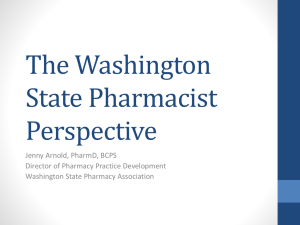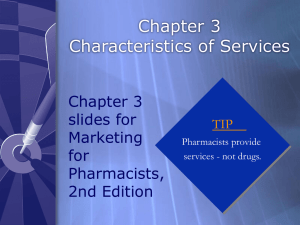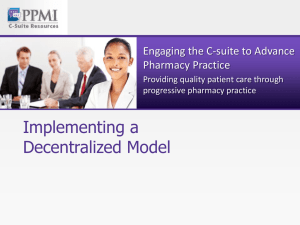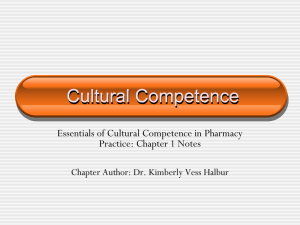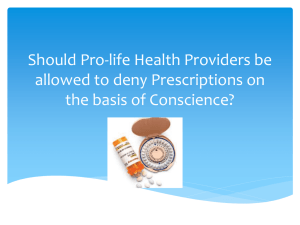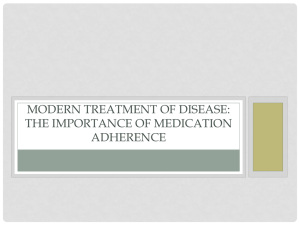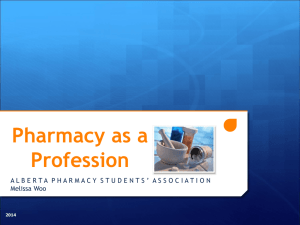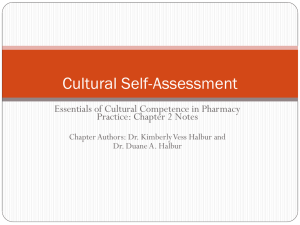Gary Matzke - VCU Health Sciences
advertisement
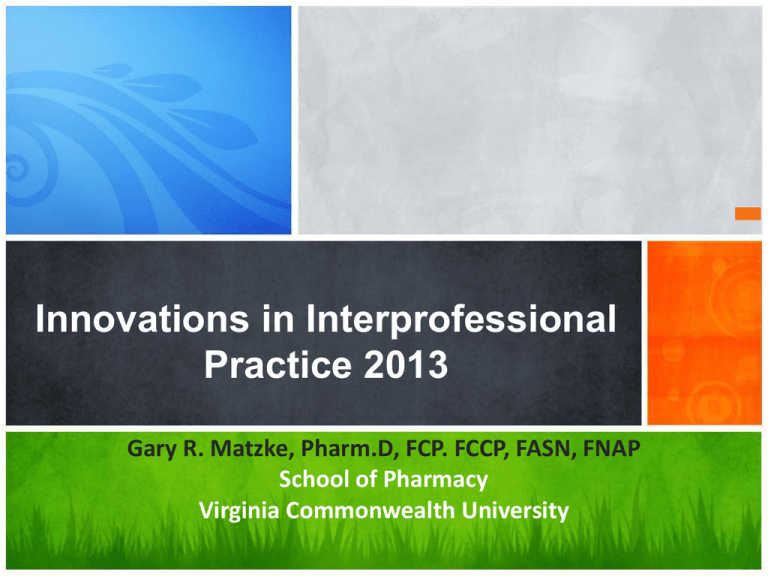
Innovations in Interprofessional Practice 2013 Gary R. Matzke, Pharm.D, FCP. FCCP, FASN, FNAP School of Pharmacy Virginia Commonwealth University Learning Objectives • Identify key events that have shaped interprofessional education and practice transformation. • Describe the interprofessional care models in which academic pharmacists have practiced in Virginia. • Characterize the "Improving Health of At risk Rural Patients" interprofessional care model Activities at the State Level • Gov. McDonnell establish a Healthcare Reform Advisory Council • What issues are important to Virginians? • It has been a very active process • Advisory Committee made up of 30 people, 6 subcommittees • Medicaid, Workforce, Insurance costs, Telemedicine • Report: Dec 2010 -- 28 recommendations on how Virginia should move forward • www.HHR.virginia.gov Pharmacy Practice Transformation at the State Level • The Virginia Pharmacy Congress reviewed the December 2010 report of the Virginia Health Reform Initiative Advisory Council • Collectively the Congress supported the statement from that report suggesting “changing scope of practice laws to permit more health professionals to practice up to the evidence-based limit of their training”. • The Congress crafted a policy position document that addressed the value that pharmacists can bring to direct patient care and identified the barriers to integration of pharmacists in interprofessional practices and thus the broad provision of these clinical services in Virginia. Pharmacy Practice Transformation Following an initial diagnosis, pharmacists can deliver a number of patient care services in a variety of practice settings through collaborative practice agreements with other healthcare providers • • • • • • • Perform or obtain necessary assessment of the health and functional status of each patient; Initiate, modify or discontinue treatment to manage disease according to therapeutic goals agreed upon by the primary provider and the patient; Order, interpret and monitor laboratory tests; Formulate clinical assessments and develop therapeutic plans; Document and communicate essential information about the care delivered to other appropriate health care providers; Provide education and training to the patient or caregiver designed to enhance understanding and appropriate use of medications and adherence with treatment regimens; Provide care coordination and services for wellness and disease prevention. 2011 U.S. Surgeon General’s Recommendations Pharmacists Interprofessional Care in the Community • Models: Service, Education, Scholarship • Goals: Enhance Medication Access, Safety, and Outcomes • Roles: Patient, Provider, Learner Education • Coordinated Care within “system” • Engaged with Community Partners • Interprofessional IHARP Project Improving Health of At-Risk Rural Patients Key Principals Michael J. Czar RPh, PhD – Project Coordinator William T. Lee RPh, MS – Principal Investigator Anthony R. Stavola MD– Co-Principal Investigator Gary R. Matzke Pharm.D. – Co-Principal Investigator Leticia R. Moczygemba Pharm.D., PhD – Co-Investigator Charles Tarasidis RPh – Director, Carilion Retail Pharmacy Operations Chad Alvarez RPh – Director, Pharmacy TSG/Epic Initiative Karen J. Williams Pharm.D. – Lead Primary Care Clinical Pharmacist Heidi Wengerd Pharm.D.- Primary Care Clinical Pharmacist Health Care Needs of Community Reasons for Hospitalizations Planning District Heart Disease Cerebrovascular Disease COPD Diabetes Asthma State of Virginia 98.1 26.9 17.8 15.1 11.8 Alleghany 108.9 31.9 21.5 17.4 10.2 Central Shenandoah 104.9 25.4 18.2 25.8 9.0 Central Virginia Cumberland Plateau Mount Rogers 101.9 31.9 25.4 22.1 15.1 114.4 20.8 78.8 18.7 21.5 69.7 17.8 21.8 14.8 6.9 New River 138.2 29.2 30.0 17.1 10.3 Roanoke City West Piedmont 125.1 102.7 31.2 26.9 30.8 29.3 33.5 26.7 18.7 12.2 The number of hospitalizations is the age-adjusted rate per 10,000 people. statistically significant difference Source: Chronic Disease Indicators by Health District 2010. Improving Health of At Risk Rural Patients • Create a sustainable patient centered continuity of care process within a rural health system comprised of multiple hospitals, primary care practices, and community pharmacies; • Achieve better health outcomes for patients by establishing a coordinated “community-based,” individualized prevention and wellness strategy • Reduce costs by optimizing medication-related health outcomes of hospitalized and ambulatory patients; • Implement two new models of pharmacist workforce development and training; and • Evaluate the clinical, humanistic and economic outcomes associated with this new health care delivery model Carilion Clinic Characteristics Service Area Resources, etc. (FY 2011) • • Headquartered in Roanoke, Va., Carilion Clinic serves the residents of 18 counties and six cities in western Virginia and southern West Virginia. • • Primary Service Area (PSA): 653,717 Secondary Service Area: 334,379 Community Benefit • • • • Uncompensated Care: $106.7 million Education: $20.4 million Research: $ .7 million Total: $131.1 million • • • • • • • Employed physicians: 575 representing more than 60 specialties Practice sites: 160 Primary care visits: 767,283 Employees: 10,975 Licensed beds: 1,187 (does not include 60 Neonatal ICU beds available) Admissions: 49,074 Emergency Department visits: 179,664 Total revenues: $1.28 billion (net) The Role Of Pharmacists in the “Medical Home” • Pharmacists should play key roles as team members in medical homes, • Their potential to serve effectively in this role should be evaluated as part of medical home demonstration projects. • 71 percent of physician office visits had at least one prescription listed in the patient record. • 32 percent of adverse events leading to hospital admission were attributed to medications • 33–50 percent of patients with chronic conditions adhere completely to prescribed medication therapies Interprofessional Practice is Crucial to our Future • Team members work closely together, • They collaborate and communicate frequently, establish team goals, and support each other’s contributions, while each shares his or her own knowledge and skill set, • Team members are involved in problem solving beyond the confines of their own disciplines; they are partners in designing a plan of care; they have joint responsibility for action, • The team capitalizes on its diversity and executes its work in a flexible and synergistic manner. A Team must have a Common Game Plan or Strategy • True teamwork depends on the mutual exchange of sufficient patient information and a sharing of decision-making, so that the team can function as an efficient, coordinated unit to the benefit of the patient. • Teams succeed when each member is willing to look past their needs and contribute to the common good of in this case THE PATIENT • Pharmacists in community settings have long been hampered in their goal of providing direct patient care because they have had insufficient patient medical information Key Elements for Successful Practice • Can’t be a provider of care if you don’t know where the patient is clinically! It starts there, not with the medications • Must know the clinical status of the patient related to each and every condition that is being prevented or treated by drug therapy (or should be treated by drug therapy) • Can’t assess the adequacy of the meds if you don’t know the stage of the disease • The days of pen and paper records are over- robust IT and clinical pathways required • Must be capable of recognizing and making evidencedbased recommendations to resolve drug therapy problems to obtain clinical goals of therapy Institutional Component PHARMACY ADMISSION NOTE PHARMACY CONSULT NOTES/Interventions Pharmacy Discharge Note / Summary of Medication Issues Recommendations for MD, Patient, PCCP, & CP Patient Community Pharmacists Non Carilion Practices Community Component Patient follow up post DC & ongoing Primary Care Pharmacist Medication Management Care Plan Provide ongoing care as part of health care team. Carilion PCMH Primary Care Component IHARP Impact Map Community Pharmacies & Providers CMM Medication Reconciliation Medication Adherence ADE Monitoring Monitoring Drug Therapy Outcomes Disease State Education and Management Carilion PHYSICIANS PATIENT Drug Information for Physicians and Providers Up-to-Date Medication List Coordination of Care Carilion PROVIDERS Monitor and Clarify Incomplete Prescribed Drug Orders Public Health of Southwest Virginia • We utilized a three tiered approach to enhance the practice skills of our pharmacists • The ADAPT process developed by the Canadian Pharmacists Association was the foundational initiative for our hospital and primary care pharmacists • The VCU MTM training program was the mechanism through which we integrated community pharmacists • Finally the Carilion IT staff developed an EPIC training program for community pharmacists Collaboration It’s about team work, and partnership building will get you there. Phase One Rollout 2013 IHARP RX IHARP RX IHARP RX IM-Christiansburg FM- Radford FM & OB-Christiansburg St. Alban’s / CNRV FM-Floyd FM-Shawsville FMNorth Main FM-Blacksburg IHARP RX FM-Pearisburg IHARP RX IHARP RX CGCH Tazewell FM-Narrows IHARP RX Health Outcomes Evaluation • Clinical, economic, and humanistic outcomes will be evaluated quarterly. • Disease specific clinical measure outcomes will be assessed from baseline to last visit. • Patient satisfaction and physician, nursing staff, and pharmacist perceptions of IHARP will be evaluated quarterly • The economic analysis will ascertain the impact of this intervention strategy on participants overall healthcare costs by: • comparing their health care utilization in the year prior to participation with the utilization during the final year of the project. • Comparing the costs of a matched comparison group selected retrospectively from those monitored in the same time frame. Implementation Challenges • Establishing a community expectation for pharmacist’s delivered clinical services • Development of consistent practice deliverables • Improving Health Information Technology • Future innovations in funding • Student and practitioner education and training Future Directions • Engage other communities within Virginia in health care system reform to increase access, improve quality, and reduce the cost of health care. • Disseminate the results of the project broadly in peer –reviewed journals and via non-traditional means such as community presentations to business and corporate leaders, government agency officials, and health care consumer organizations. • Partner with others across the country to assess the value of implementing similar care models in other populations. Interprofessional Practice is OUR FUTURE DISCUSSION
